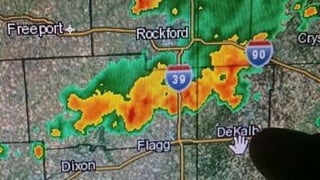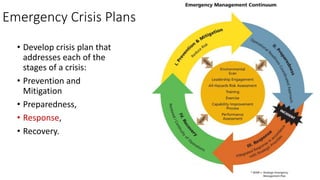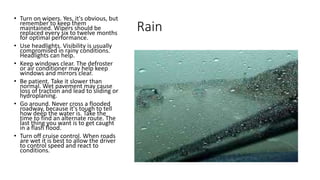Extreme Weather 2017
- 1. Extreme Weather Emergency Planning Continuity of Operations
- 2. Internal Response Plans Basic response plans focus on incidents from internal sources or local events •Medical •Fire •Chemical spills or releases •Bloodborne Pathogens •Weather •Power outage •Confined Space
- 3. External response plans Accidental incidents from externally caused events and sources •Emergency at neighboring facility •Severe weather •Natural disasters •Utility failure, electricity, Gas •Trucking •Rail lines •Airports •Avian/swine flu – other pandemics
- 4. Potential Natural Disasters • Earthquakes • Flash Floods • Hurricanes • Tornadoes • Energy/utility outages • Fire hazards
- 5. Severe Weather • Designate person to monitor local weather radar when severe weather is expected. • Monitor weather radio, carry FRS radios with weather channel. • Different levels of response if employees work outside. • Simply coming inside, versus tornado sheltering. • Different methods of alerting outside workers versus inside workers • What are the plans if you need to evacuate during a severe storm? • Be prepared with backup internal evacuation zones, nearby business sites, or evacuation transportation plans.
- 6. Earthquakes • On January 17, 1994, San Fernando Valley, rocked with a 6.7 magnitude earthquake • 57 dead, 1,500 people were seriously injured • 9,000 homes and businesses without electricity; 20,000 without gas; more than 48,500 had little or no water • 6% of the over 66,546 buildings severally damaged or destroyed
- 7. Earthquakes • Insurance? • Cell Phones Work? • Structural Damage • Continuity of Operations • Headcount
- 8. Flood • Flood Plain Map
- 10. Lightning • June 2017 • Pemboke Pines FL • One construction worker has died and another was hospitalized after being struck by lightning
- 11. Lightning • Sep 2016 • Miami FL • Several units responded and the worker was hoisted down the building. • He had to be hoisted after there was a power outage in the building due to the storm that knocked out elevator service, officials said.
- 12. Reporting and Alerting Emergencies • How and what warning will be provided through alarm system • Procedures for sounding alarms in workplace – Voice communication is acceptable for employers with 10 or fewer employees
- 13. Tornadoes • Violent windstorms characterized by twisting, funnel-shaped clouds • Damage typically results from high winds and wind- blown debris • Typical season is March thru April, but can occur at any time, anywhere • 80 percent occur between noon and midnight
- 14. Feb 2017 • Naplate IL • Pilkington Glass had two tornado shelter. • Direct hit by F3 tornado • No one suffered injuries in Pilkington factory as result of tornado.
- 15. Tornados • Roanoke IL • F4 • July 13, 2004 • Parsons Mfr • The walls of the shelters were 10 inches thick • Concrete ceilings 18 inches thick
- 16. Parsons • The shelters were constructed of poured concrete, reinforced with 5/8” rebar
- 17. May 8, 2003 • The take shelter signal is sounded at 5:08 p.m. • All 100 employees were sheltered by 5:18 p.m. • An F4 tornado hit the plant at 5:30 p.m. • 100 paint shop employees sought shelter in the 500- square-foot, cinder block canteen.
- 22. Issue • “Using a few bathrooms as a shelter in place location without thinking about the reality of trying to cram too many people into too few bathrooms. • Also for those areas that may get a few tornado warning notices even while sky's are clear but having no good plan to know when it's time to move to a shelter.” - Pam S
- 23. Issue • “If a headcount coordinator for a dept calls in their numbers to the Incident Commander & says "we got everyone but Joe is missing." • Then the plan is to "sweep" & find Joe but ... no one is every really sure who is to "sweep" & ya de ya de ya de ... it is never assigned & how is the assigned one kept safe, etc.” • Susan L
- 24. Blizzard • Maine ice storm • No electricity for 5 weeks.
- 25. Powerlines hits • 2005 Springfield
- 26. Energy Shortage/Utility Outages • More than 50 million people affected by blackout in August 2003 • Potential still exist • Could be caused by – Increase demand – Equipment failure, damage, or line loading – Rapid growth – Cutbacks due to conservation – Renewable programs
- 27. Issues • Lack of planning for employees forced to evacuate during extreme temperatures. • Management not having an up to date list daily, or even hourly, of employees and their whereabouts. • Angeline H
- 28. Power failures • Who is responsible for equipment shutdown and startup? Maintenance, operators, what if off shift? • Computer server backup, battery UPS for transients and switchover time, IT services needed to bring back on line if they go down. • How will you continue business if the server is located at a different site than yours? • Employees will remain in safe areas until power is restored or released from the building by senior management. • Emergency lighting? What about parking lots at night? Flashlights? • How are the response teams affected by lack of power? Air quality? Stored energy?
- 29. Backup Electric Generators Diesel or Natural Gas Generator backup, fuel sources –issues of supply of natural gas, propane, versus diesel, what areas of building covered, and what is generator turn on time.
- 30. Emergency Crisis Plans • Develop crisis plan that addresses each of the stages of a crisis: • Prevention and Mitigation • Preparedness, • Response, • Recovery.
- 31. Response planning issues • Exact plans are different for each site, response team, or business. • Danger of operation in a vacuum. • Better to identify ways to prevent emergencies rather than ways to respond. • Personal safety is 1st priority, employees, community. • Also plan for Intellectual property, physical property, environment, and business continuity. • Incidents can escalate upwards to, or down from, City, County, State and Federal responses.
- 32. Response Planning Issues • Questions that determine your own responses to emergencies • What risks could trigger the emergency? • What is the likelihood of the emergency? • How severe would the emergency be? • Who would be impacted by the emergency? • What are the capabilities of your teams? • Training levels of the team members? • What kind of and quantity of supplies on hand? • How much responsibility can your site assume Vs. contract response out? • What kind of supplies for sheltering in place? Food, Water, Sanitary? • How will the emergency be communicated to responders, employees, families, community? • Emergencies rarely happen just the way they are anticipated, expect combinations of risks at same time.
- 33. Emergency Preparedness Drills • At Least Annual Emergency Preparedness Drills • This is not Just an Emergency Evacuation… • but Could Include HAZWOPR Response • Must Document Results • “My experience was they didn't ever re-visit emergency phone numbers & just familiarity of the plan.” – Becky S
- 34. Plan Evolution • Multiple levels of Response plans • Integration of risks through planning and practice • Plan on continual updates of plans • -Contact phone numbers • -Responsibility and management changes • -Facility changes • -Resource changes • -Risk changes • OK to use everyone else’s best practices
- 35. A - Site level plan • Localized incident, within site • Develop responses to internal and external events using team capabilities • Table tops and drills with internal teams • Table tops and drills with fire/police/EMT’s • VPP sites are at least this level
- 36. B - Campus level plan • Impacts portions of a business campus, neighboring plants, or industrial complex. • Develop common responses, escalation plan, and mutual aid with nearby sites and security. • Escalation flowchart -Who owns the phone tree? • Common communications platforms, cell phones, radios, networks. • Designated situation room away from operations. Communications resources? • Table tops and drills with fire/police/emergency management. • Drive changes back to site level.
- 37. C - Community level plan • Emergency that involves the entire campus, industrial area, or surrounding community. • Tabletops with community services in attendance. Develop response plans utilizing their capability and limitations. • Table tops and drills with nearby businesses. • Table tops and drills with emergency management.
- 38. Outside Resources • Coordinate response plans with external services -Know their capabilities and response times • Police Department • Fire Department • Ambulance, EMT, paramedic, hospital • Public water supply authority • Public health authority • Hazardous waste handler • Weather service • Local media • Neighboring facilities • Local emergency government • Incident Command
- 39. Incident Escalation Flowchart Site Incident Site Response Teams Escalate to Campus Level Escalate to Corporate / community Level Outside Services Outside Services Outside Services, Emergency Gov. done Community Incident
- 40. Plan to stay in business • Keep Informed - Know what kinds of emergencies might affect your company. (Perform risk assessment) • Communications - Ability to communicate with your employees and co-workers before, during, and after an emergency. Website, email alert, call-in voice recording. Designate an out of town phone number where employees can leave an “I’m Okay’ message. • Emergency Supplies - Think first about the basics of survival: fresh water, food, clean air and warmth. Think short and long term. • Deciding to stay or go - Shelter-in-place or evacuate, plan for both possibilities. Use common sense, monitor radio/TV for official instructions. Designate evacuation zones nearby and also further away. Coordinate with other sites or tenants to avoid confusion and gridlock.
- 41. Continuity Planning • Carefully assess how your company functions, both internally and externally. Include suppliers and customers in your planning • Carefully assess to determine which staff, materials, procedures and equipment are absolutely necessary to keep the business operating. • Identify your suppliers, shippers, resources and other businesses you must interact with on a daily basis. • Plan what you will do if your building, plant or store is not accessible. This type of planning is often referred to as a continuity of operations plan, or COOP, and includes all facets of your business. • Plan for payroll continuity. • Define crisis management procedures and individual responsibilities in advance. • Coordinate with others. Neighboring plants, suppliers, vendors, shippers • Review your emergency plans annually.
- 42. Integrate NIMS into your response plans • NIMS – National Incident Management System • Federal standard for all emergencies, stems from the NRF - National Response Framework. • Fire, police, state and federal agencies, emergency government all use NIMS as an incident framework. • ICS, – Incident Command System, is a standardized organization structure that: • -Establishes a line of authority • -Standard organizational structure • -Common terminology • -Common procedures to be followed in response to an incident.
- 43. ICS with Private Sector Representatives Operations Section Planning Section Logistics Section Finance Administration Section Safety Officer Liason Section Public Information Section Incident Command Emergency Operations Center Joint Information Center P P P P
- 44. July 2015 • A Santa Fe jury awarded a $165.5 million verdict Friday in connection with a triple-fatal crash west of Las Cruces. • Fedex driver had been taking medication for sleeping problems related to late-night driving and was driving about 65 mph when she slammed into the rear of the young mother’s truck. • “FedEx Ground had no safety program, no safety manual for danger zone driving nor fatigue,” Midnight and 6 a.m. — otherwise known in the trucking industry as the “danger zone,” when accidents are seven times more likely to occur
- 45. Driving Company Cars or Taking Calls • Zurich is seeing large increase in lawsuits
- 46. Ice or snow • Slow down. Bridges and overpasses freeze first, so take it slow and avoid sudden changes in speed or direction. • Keep windows clear. • Visibility is crucial, especially in bad weather. • Turn on the wipers and crank up the defroster, if necessary. • Also make sure that all items are removed from the back window area. • If you're still having trouble seeing, carefully pull over to a safe location at the side of the road. • Brake cautiously. • Abrupt braking can cause lock-up and loss of steering control. • If you have anti-lock brakes, apply constant, firm pressure to the pedal. • Resist the urge to 'floor it.’ • If you get stuck in snow, straighten the wheels and accelerate slowly. • Avoid spinning the tires. • Use sand or blocks under the drive wheels.
- 47. Rain • Turn on wipers. Yes, it's obvious, but remember to keep them maintained. Wipers should be replaced every six to twelve months for optimal performance. • Use headlights. Visibility is usually compromised in rainy conditions. Headlights can help. • Keep windows clear. The defroster or air conditioner may help keep windows and mirrors clear. • Be patient. Take it slower than normal. Wet pavement may cause loss of traction and lead to sliding or hydroplaning. • Go around. Never cross a flooded roadway, because it's tough to tell how deep the water is. Take the time to find an alternate route. The last thing you want is to get caught in a flash flood. • Turn off cruise control. When roads are wet it is best to allow the driver to control speed and react to conditions.
- 48. Fog • Turn on the low beams. Day or night, headlights should be on and set to low beam. • Wait it out. If you're having trouble seeing, safely pull over to the right side - well out of the traffic lane - and turn on your emergency flashers. Wait until visibility improves before continuing.
- 49. High Winds • Look out. Keep an eye out for flying debris. And use extra caution near trailers, vans, or vehicles carrying lightweight cargo. • Some cars shouldn't be driven. It's best not to drive a trailer, van, or other 'high-profile' vehicle (autos with high centers of gravity like SUVs and trucks) in high winds
- 50. Severe Thunderstorms • Turn on headlights and wipers. • Listen to the radio. Tune into a local weather station for storm and traffic updates.
- 51. Hailstorm • Find shelter. Take cover by pulling over under an overpass or bridge.
- 52. All Weather Safety • Buckle up. Every trip, every time. • Focus on your destination and avoid distractions. • Pack and store an emergency kit in your trunk or cargo area with items you could use in the event of a roadside situation.





















































